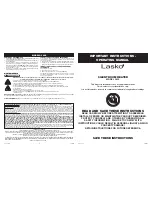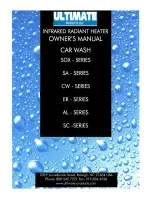
lp-441 Rev. 002 Rel. 008 Date 8.23.18
12
Dielectric unions or galvanized steel fittings must not be used in a
system with this water heater. Doing so WILL VOID the warranty. Use
only copper, brass, or stainless steel fittings. Teflon thread sealant
must be used on all connections.
A. Heater Plumbing
Use two wrenches when tightening water piping at heater. Use one
wrench to prevent the heater return or supply line from turning.
Failure to prevent piping connections from turning could cause
damage to heater components.
The heater control module uses temperature sensors to provide
both high limit protection and modulating temperature control.
The control module also provides low water protection by sensing
the water level in the tank. Some codes / jurisdictions may require
additional external controls.
The domestic water connections must be installed in accordance to all
local and national plumbing codes, or any applicable standard which
prevails. The inlet (cold) and outlet (hot) ports are 3/4” on all models.
It is recommended to install a sweat shut-off valve and a union in the
cold inlet piping and hot outlet to ease future servicing. If there is a
backflow preventer or any type of a no return valve in the system, install
an additional tee here, suitable for a potable hot water expansion tank.
In the hot outlet, install a suitable adapter to match the copper tubing
of the plumbing system. A thermal trap or heat trap loop may be
installed here to provide additional energy savings and prevent the
thermal siphoning of domestic hot water.
B. Auxiliary Connections
The auxiliary connections are additional connections for a recirculation
connection, air handlers, plate exchangers, or other devices that supply
hot water. These connections must be installed in accordance with
all local and national codes or any applicable standard that prevails.
Auxiliary connections are 3/4” on all models. Never use dielectric
unions or galvanized steel fittings. Use only copper or brass fittings.
Sealant must be used on all connections.
Never connect auxiliary connections to any system that uses glycol
or other solutions formulated for hydronic systems. These auxiliary
connections are to be used only in a potable water system. Failure to
follow this warning could result in serious injury or death.
C. Backflow Preventer
D. Potable Expansion Tank
A potable hot water expansion tank is required to offset heated water
expansion. In most city plumbing systems, the water meter has a
no return or back flow device built into the system to prevent back
flowing of water into city mains. Some local codes require back flow
preventers on all incoming water supplies. The hot water expansion
tank must be listed for potable water use. The expansion tank should
be located on the cold inlet piping close to the water heater.
Undersized expansion tanks cause system water to be lost from the
relief valve, causing make-up water to be added. Eventual heater
failure can result due to excessive make-up water addition.
SUCH
FAILURE IS NOT COVERED BY WARRANTY.
The expansion tank must be suitable for hot potable water systems.
2. The expansion tank must be located as shown in Applications, this
manual, or following recognized design methods. See expansion tank
manufacturer’s instructions for details.
Use a backflow preventer specifically designed for water heater
installations. This valve should be installed on the cold water fill supply
line per local codes.
E. Temperature and Pressure Relief Valve
To avoid water damage or scalding due to relief valve operation:
•
Discharge line must be connected to relief valve outlet and
run to a safe place of disposal. Terminate the discharge line
in a manner that will prevent possibility of severe burns or
property damage should the relief valve discharge.
•
Discharge line must be as short as possible and the same
size as the valve discharge connection throughout its entire
length.
•
Discharge line must pitch downward from the valve and
terminate at least 6” above the floor drain, making discharge
clearly visible.
•
The discharge line shall terminate plain, not threaded, with
a material serviceable for temperatures of 375
o
F or greater.
•
Do not pipe discharge to any location where freezing could
occur.
•
No valve may be installed between the relief valve and heater
or in the discharge line. Do not plug or place any obstruction
in the discharge line.
•
Test the operation of the relief valve after filling and
pressurizing the system by lifting the lever. Make sure the
valve discharges freely. If the valve fails to operate correctly,
immediately replace with a new properly rated relief valve.
•
Test T&P valve at least once annually to ensure the waterway
is clear. If valve does not operate, turn the heater “off” and call
a plumber immediately.
•
Take care whenever operating relief valve to avoid scalding
injury or property damage.
FAILURE TO COMPLY WITH THE ABOVE GUIDELINES COULD RESULT
IN FAILURE OF RELIEF VALVE OPERATION, RESULTING IN POSSIBILITY
OF SUBSTANTIAL PROPERTY DAMAGE, SEVERE PERSONAL INJURY,
OR DEATH.
Overheated water and high pressures can cause water tank
explosion. A properly sized temperature and pressure relief valve
must be installed in the opening provided on the water heater.
Failure to install a properly sized temperature and pressure relief
valve could result in explosion and property damage, serious injury,
or death.
Expansion Tank and Make-Up Water
1. Ensure that the expansion tank is sized to correctly handle heater
and system water volume and temperature.
RE-INSPECTION OF T&P RELIEF VALVES: T&P valves should be
inspected AT LEAST ONCE EVERY THREE YEARS, and replaced
if necessary,
by a licensed plumbing contractor or qualified
service technician to ensure that the product has not been affected
by corrosive water conditions and to ensure that the valve and
discharge line have not been altered or tampered with illegally.
Certain naturally occuring conditions may corrode the valve and
its components over time, rendering the valve inoperative. Such
conditions can only be detected if the valve and its components are
physically removed and inspected.
Do not attempt to conduct an
inspection on your own.
Contact your plumbing contractor for a
re-inspection to assure continued safety.
Do not thread a cap or plug into the relief valve or relief valve line
under any circumstances! Explosion and property damage, serious
injury, or death may result.













































